By May of this year, Waymo began allowing some early riders in Phoenix to hail a self-driving minivan without a human test driver behind the wheel.
Wednesday, 31 October 2018
Apple launches the most powerful Mac mini starting at $799
Along with the new MacBook Air, Apple has launched new Mac mini systems with 4-core and 6-core processors. Apple claims up to 64GB of faster memory and five times faster performance. As far as the performance is concerned, Apple claims it to be the most powerful Mac mini ever made.from Gadgets Now https://ift.tt/2PtTJOJ
via IFTTT
OnePlus 6T launched in India, price starts at Rs 37,999
The wait is finally over for OnePlus 6T's India fans.from Gadgets Now https://ift.tt/2Q6skjb
via IFTTT
Apple launches thinnest-ever iPad Pro; comes with FaceID, slim bezels
The new Apple iPad Pro is here. The company launched the new iPad Pro at an event in Brooklyn, New York.from Gadgets Now https://ift.tt/2OWg2NI
via IFTTT
New MacBook Air (2018) with Retina Display, TouchID and more launched
As widely speculated, Apple has announced update to its cheapest MacBook series, MacBook Air.from Gadgets Now https://ift.tt/2Q4zpR7
via IFTTT
Ziox Mobiles launches Duotel D1 smartphone, priced at Rs 5,399
Ziox Mobiles has introduced its budget smartphone range Duotel in the Indian market.from Gadgets Now https://ift.tt/2qk8aXq
via IFTTT
OnePlus 6T outshines Xiaomi Black Shark to become the 2nd ‘best performing’ Android smartphone
OnePlus has just introduced its OnePlus 6T smartphone that is an upgrade over the OnePlus 6 smartphone. Although both the smartphones are powered by the same Qualcomm Snapdragon 845 processor along with 6GB or 8GB LPDDR4X RAM, the newer variant is claimed to be ‘better performing’ than the flagship OnePlus 6. Now, re-confirming the claim, Antutu, the smartphone and PC testing platform has revealed the OnePlus 6T results, placing it as the second best performing Android handset in the list.from Gadgets Now https://ift.tt/2OVRHaR
via IFTTT
Now Apple iPhone users can try Microsoft Outlook email features before others, here's how
Microsoft often gives select users a sneak peek at some of the features before they roll out to end users. This ‘privilege’ is given to those Office Insiders who are a part of the beta program. The program until now included early builds of Microsoft Excel, PowerPoint and OneNote. Now, the Redmond-based tech firm has included Microsoft Outlook for Apple iPhone users in it as well. This means Office Insiders on iOS will be able to test some Outlook features before others.from Gadgets Now https://ift.tt/2OeWPS0
via IFTTT
Nokia 6.1 becomes the first to get Android 9.0 Pie OS update
HMD Global, the ‘Nokia’ smartphone maker has announced Android 9.0 Pie rollout for Nokia 6.1, the smartphone that launched in April this year. Nokia 6.1 will start receiving Android 9 Pie from today (October 30). However, it may take some time to reach all the users across the globe. It is also the first in the lineup to get Android 9 Pie. and second to receive the latest version of Android under a month after the update arrived. The first was Nokia 7 Plus (for Android Oreo).from Gadgets Now https://ift.tt/2yIwk2G
via IFTTT
Paytm Maha Cashback Sale: Discounts up to 68% on boAt headphones and speakers
Paytm Mall is also offering a range of discounts and cashbacks on various products under its Maha Cashback Sale.from Gadgets Now https://ift.tt/2OeWC1a
via IFTTT
OnePlus 6T India launch updates: Oneplus 6T live stream, price & more
from Gadgets Now https://ift.tt/2Jsmshq
via IFTTT
Brex has partnered with WeWork, AWS and more for its new rewards program
Brex, the corporate card built for startups, unveiled its new rewards program today.
The billion-dollar company, which announced its $125 million Series C three weeks ago, has partnered with Amazon Web Services, WeWork, Instacart, Google Ads, SendGrid, Salesforce Essentials, Twilio, Zendesk, Caviar, HubSpot, Orrick, Snap, Clerky and DoorDash to give entrepreneurs the ability to accrue and spend points on services and products they use regularly.
Brex is lead by a pair of 22-year-old serial entrepreneurs who are well aware of the costs associated with building a startup. They’ve been carefully crafting Brex’s list of partners over the last year and say their cardholders will earn roughly 20 percent more rewards on Brex than from any competitor program.
“We didn’t want it to be something that everyone else was doing so we thought, what’s different about startups compared to traditional small businesses?” Brex co-founder and chief executive officer Henrique Dubugras told TechCrunch. “The biggest difference is where they spend money. Most credit card reward systems are designed for personal spend but startups spend a lot more on business.”
Companies that use Brex exclusively will receive 7x points on rideshare, 3x on restaurants, 3x on travel, 2x on recurring software and 1x on all other expenses with no cap on points earned. Brex carriers still using other corporate cards will receive just 1x points on all expenses.
Most corporate cards offer similar benefits for travel and restaurant expenses, but Brex is in a league of its own with the rideshare benefits its offering and especially with the recurring software (SalesForce, HubSpot, etc.) benefits.
San Francisco-based Brex has raised about $200 million to date from investors including Greenoaks Capital, DST Global and IVP. At the time of its fundraise, the company told TechCrunch it planned to use its latest capital infusion to build out its rewards program, hire engineers and figure out how to grow the business’s client base beyond only tech startups.
“This is going to allow us to compete even more with Amex, Chase and the big banks,” Dubugras said.
from TechCrunch https://ift.tt/2DeuUk6
The Tissot Seastar 1000 is a low-cost and high-quality Swiss diver
In the pantheon of watches there are a few that stand out. Looking for your first automatic watch? Pick up a Seiko Orange Monster. Looking for a piece with a little history? The Omega Speedmaster is your man. Looking for an entry-level Swiss diver that won’t break the bank? Tissot’s Seastar has always had you covered.
The latest version of the Seastar is an interesting catch. A few years ago – circa 2010 – the pieces were all black with bold hands and a more staid case style. Now Tissot, a Swatch Group brand, has turned the Seastar into a chunkier diver with massive bar hands and case that looks like a steel sandwich.
The $695 Seastar 1000 contains a Powermatic 80/ETA C07.111 movement with an eighty hour power reserve which means the watch contains a massive mainspring that keeps things going for most of three days without winding. The Seastar is also water resistant to 1000 feet thanks to a huge screw down crown and thick casing. The new model has an exhibition back where you can see the rotor spinning over and balance wheel. The watch also has a ceramic bezel, a fairly top-of-the-line feature in an entry level watch.

Tissot has a long and interesting history. Best known for their high-tech T-Touch watches which had touchable crystals, allowing you to activate a compass, barometer, or altimeter with a single tap, the mechanical pieces have always seemed like an afterthought. The company also produces the classic Tissot Le Locle as well as a chronograph that I absolutely loved, the T-Navigator, but that has been discontinued. The Seastar, then, is one of the few mechanical pieces they sell and at sub-$1,000 prices you’re basically getting a Swiss watch with solid power reserve and great looks.

Watch folks I’ve talked to over the past few months see a distinct upturn in the Swiss watch market. Their belief that the Apple Watch is driving sales of mechanical watches seems to be coming true, even if it means cheaper fashion watches are being decimated. Tissot sits in that sweet spot between luxury and fashion, a spot that also contains Tag Heuer and Longines. Ultimately this is an entry level watch for the beginning collector but it’s a beautiful and beefy piece and worth a look.
[gallery ids="1739155,1739160"]from TechCrunch https://ift.tt/2ql20X9
As stock rises on a slim earnings beat, eBay tells analysts to focus on payments and ads
Despite increasing competition from traditional retailers like Walmart and Target, which have invested heavily in e-commerce, and the whupping it’s routinely taking from Amazon among pure e-commerce companies, eBay the 20-year-old lumbering Pez dispenser of an e-tailer, keeps plugging along.
Now, as it manages to eke out another earnings win by matching analysts’ expectations, the company is telling the bankers that watch it to look to advertising and payments for its future growth.
The company met analysts’ estimates of revenue totaling $2.65 billion, up from $2.41 billion in the year-ago period. That amounts to adjusted earnings of 56 cents per share, up from 48 cents per share in the year-ago period and beating analyst estimates of 54 cents per share. Profits for the company hit $720 million for the quarter.
The news sent shares up over 4 percent in trading after the market closed on Tuesday.
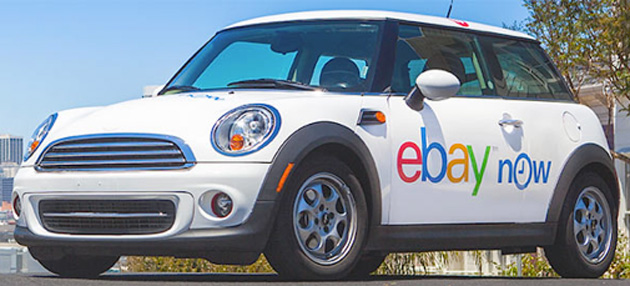
But more interesting than the the tepid results was its outlook for the future. Right now, eBay is at a crossroads as it tries to get a new group of users to forget about its past as a marketplace for used goods and resellers — and as a more pure e-commerce company.
“This quarter we continued to make foundational investments to improve the long-term competitiveness of our marketplace while setting the stage for significant growth opportunities,” said CEO Devin Wenig in a statement. “We will continue to innovate the customer experience while executing our growth initiatives in Payments and Advertising to position eBay for future success.”
The fact is, eBay is growing. It saw the number of active buyers across the platform increase by 4 percent, and has 177 million global active buyers. While that number is dwarfed by Amazon’s over 300 million global buyers (as of 2017), it’s one of the largest retailers in the U.S. The company’s StubHub business saw revenues of $291 million, up 7 percent from the year-ago period and sales of $1.2 billion. Its classified payments also grew.
As eBay looks ahead, payments and advertising are going to receive a bulk of the company’s internal investment dollars as it tries to complete the rollout of a new payment experience in the wake of its divorce from PayPal and its embrace of Adyen, Apple Pay, and the technology-based financial services company, Square.
The company has already processed $38 million in payments and through the partnership with Apple Pay has grown that payment method to 12 percent on the platform. Advertising on eBay has seen 400,000 sellers promote over 160 million listings.
“We continue to grow the inventory on the marketplace,” Schenkel. “Just recently we rolled out a direct from brand and direct from authorized resellers… Brands want choice and they want to sell on a marketplace with 177 million users that doesn’t compete with them.”
The company will also continue to have an aggressive investment and mergers and acquisitions strategy, the executives said. Especially since the company found its earnings buoyed by the $1 billion it brought in from the sale of its stake in Flipkart, href="https://techcrunch.com/2018/05/09/walmart-confirms-16b-flipkart-investment-giving-it-77-in-indias-e-commerce-leader/"> when it was bought by Walmart for $16 billion.
What’s somewhat interesting is that there are new companies in the retail space that are making a mint doing things that eBay once dominated. Vinted and DePop are both used-clothing e-tailers that have enviable cache and significant revenues, while LetGo and OfferUp are also raiding used goods to turn trash into treasure.
A quick trip to eBay’s homepage shows that the company has all but consigned its collectible past to the trash heap. Given the death and dissolution of so many of its peers from the first generation of internet giants, it’s worth keeping an eye on eBay if only to see how the 20-something company approaches middle age as an independent entity.
“We have a unique situation. [The] eBay brand is very well recognized and not as well understood. We’re seeing this; that new buyers are responding really well to the changes that we made in the last few years and we need more of them and part of that is messaging our brand,” said Wenig on the earnings call with investment analysts.
from TechCrunch https://ift.tt/2DcyQ57
Facebook bans the Proud Boys, cutting the group off from its main recruitment platform
Facebook is moving to ban the Proud Boys, a far-right men’s organization with ties to white supremacist groups. Business Insider first reported the decision. Facebook confirmed the decision to ban the Proud Boys from Facebook and Instagram to TechCrunch, indicating that the group (and presumably its leader Gavin McInnes) now meet the company’s definition of a hate organization or figure.
Facebook provided the following statement:
“Our team continues to study trends in organized hate and hate speech and works with partners to better understand hate organizations as they evolve. We ban these organizations and individuals from our platforms and also remove all praise and support when we become aware of it. We will continue to review content, Pages, and people that violate our policies, take action against hate speech and hate organizations to help keep our community safe.”
Even compared to other groups on the far right with online origins, the Proud Boys maximize their impact through social networking. The organization, founded by provocateur and Vice founder McInnes, relies on Facebook as its primary recruitment tool. As we reported in August, the Proud Boys operate a surprisingly sophisticated network for getting new members into the fold via many local and regional Facebook groups. All of it relies on Facebook — the Proud Boys homepage even links out to the web of Facebook groups to guide potential recruits toward next steps.
At the time of writing, Facebook’s ban appeared to affect some Proud Boys groups and not others. The profile of Proud Boys founder McInnes appears to still be functional. Facebook’s decision to act against the organization is likely tied to the recent arrest of five Proud Boys members in New York City on charges including assault, criminal possession of a weapon and gang assault.
from TechCrunch https://ift.tt/2CSNSfu
Siri Shortcuts app gets updated with weather, alarms, timers and more
Alongside today’s announcements of new iPads and Mac, Apple also rolled out an updated version of its Siri Shortcuts app. The app, first introduced at WWDC, arrived with iOS 12 as a way to unlock Siri’s potential by allowing users to create their own custom voice commands and workflows. Now, it can do a few new things, too – including setting alarms and timers, getting the latest weather, and more.
The weather actions should be especially useful for those who have created custom morning routines with Siri Shortcuts, as you’ll now be able to use the latest weather in your shortcuts with the new “Get Current Weather” and “Get Weather Forecast” actions. Being able to ask for this sort of information is already among the top use cases for voice assistants, like Alexa and Google Assistant, so it makes sense to offer these sorts of commands to Siri Shortcuts users, as well.
With these options, you can now ask for current conditions, forecasts (hourly, daily or 10 days out), or for any specific condition – like the humidity, chance of rain, air quality, and more.
Also helpful are the new “Create Alarm,” “Toggle Alarm,” and “Start Timer” actions, which addressed another notable hole in the Shortcuts app at launch. Many people were confused about how to use alarms within the app because these actions weren’t available, and the request often came up on Apple’s own support site, too. The new release, Siri Shortcuts 2.1, addresses this problem.
Other new actions include the ability to convert between a variety of units from the “Measurement” and “Convert Measurement” actions; the ability to get the most recent set of imported photos from the Photos app using the “Get Last Import” action; and the ability to star recording video immediately in the “Take Video” action.
Interestingly, Apple didn’t call that last one out in the App Store update text – maybe because all the news attention a user-created shortcut called “Police” recently received. “Police” lets you speak a verbal command that performs a series of actions, including messaging a friend, turning down the phone’s brightness, and pausing the sounds on your phone. It then gives you a button to press to start to recording. Now, it seems you can tweak the “Police” shortcut to just begin recording right away.
The updated app also fixes a problem with using Siri Shortcuts with HomePod. It will now automatically play back media from the HomePod over AirPlay, when you run the shortcut from HomePod via Siri – which just makes more sense.
Siri Shortcuts version 2.1 is the first major update following the app’s release with iOS 12. However, the app today still largely appeals to iOS power users – those who were already comfortable using its predecessor, Workflow, and who understand how to build routines.
More mainstream users are likely being exposed to Siri’s expanded powers through their favorite apps. With iOS 12, a number of top developers updated their apps with “Add to Siri” buttons that point out special tasks their apps can perform by way of voice. Early adopters on this front included Pandora, The Weather Channel, Sky Guide, Citymapper, Google News, TripIt, Trello, Monster, and others.
The updated version of Siri Shortcuts is available for download from the App Store.
from TechCrunch https://ift.tt/2Q5yrEg
Alphabet exec Richard DeVaul is reportedly out after sexual harassment story
As Axios first reported, Richard DeVaul, a director at the entity formerly known as Google X, has left the company. An incident involving DeVaul behaving inappropriately toward a Google interviewee was cited in a New York Times report centered on the sexual misconduct of Andy Rubin last week. Google confirmed that DeVaul had resigned and will not receive an exit package.
The story recounts a 2013 incident during which DeVaul brought up his own polyamory in an interview with Star Simpson, a female hardware engineer. DeVaul reportedly invited Simpson to Burning Man. When she attended, DeVaul asked her to remove her shirt so that he could give her a massage. Simpson was not hired at Google.
Google has faced wide criticism of its decision to give Rubin a $90 million exit package in spite of an investigation finding the claims against him credible. Axios reports that DeVaul did not receive an exit package, consistent with Sundar Pichai’s recent claim that the company had fired 48 individuals for sexual harassment in the last two years without providing exit packages.
Earlier in 2018, DeVaul authored a Medium post introspecting on his experience awakening to his own latent racism and misogyny.
“We can be better people and make a more just society when we recognize this and are committed to the long-term solutions of continued personal introspection, thoughtful critique of systematic bias, and working to create new and better systems,” DeVaul wrote. “I’m committed to working on this, and I hope you will join me.”
from TechCrunch https://ift.tt/2CRQES7
Twitter’s U.S. midterms hub is a hot mess
Today, Jack Dorsey tweeted a link to his company’s latest gesture toward ongoing political relevance, a U.S. midterms news center collecting “the latest news and top commentary” on the country’s extraordinarily consequential upcoming election. If curated and filtered properly, that could be useful! Imagine. Unfortunately, rife with fake news, the tool is just another of Twitter’s small yet increasingly consequential disasters.
The midterm elections right now #Midterms2018 https://t.co/7T2IojpxWw
— jack (@jack) October 30, 2018
Beyond a promotional tweet from Dorsey, Twitter’s new offering is kind of buried — probably for the best. On desktop it’s a not particularly useful mash of national news reporters, local candidates and assorted unverifiable partisans. As Buzzfeed news details, the tool is swimming with conspiracy theories, including ones involving the migrant caravan. According to his social media posts, the Pittsburgh shooter was at least partially motivated by similar conspiracies, so this is not a good look to say the least.
Why launch a tool like this before performing the most basic cursory scan for the kind of low-quality sources that already have your company in hot water? Why have your chief executive promote it? Why why why
A few hours after Dorsey’s tweet, likely after the prominent callout, the main feed looked a bit tamer than it did at first glance. Subpages for local races appear mostly populated by candidates themselves, while the national feed looks more like an algorithmically generated echo chamber version of my regular Twitter feed, with inexplicably generous helpings of MSNBC pundits and more lefty activists.
For Twitter users already immersed in conspiracies, particularly those that incubate so successfully on the far right, does this feed offer yet another echo chamber disguised as a neutral news source? In spite of its sometimes dubiously left-leanings, my feed is still peppered with tweets from undercover video provocateur James O’Keefe — not exactly a high quality source.
In May, Twitter announced that political candidates would get a special badge, making them stand out from other users and potential imposters. That was useful! Anything that helps Twitter function as a fast news source with light context is a positive step, but unfortunately we haven’t seen a whole lot in this direction.
Social media companies need to stop launching additional amplification tools into the ominous void. No social tech company has yet exhibited a meaningful understanding of the systemic shifts that need to happen — possibly product-rending shifts — to dissuade bad actors and straight up disinformation from spreading like a back-to-school virus.
Unfortunately, a week before the U.S. midterm elections, Twitter looks as disinterested as ever in the social disease wreaking havoc on its platform, even as users suffer its real-life consequences. Even more unfortunate for any members of its still dedicated, weary userbase, Twitter’s latest wholly avoidable minor catastrophe comes as a surprise to no one.
from TechCrunch https://ift.tt/2DdFEzt
Zuckerberg says the future is sharing via 100B messages & 1B Stories/day
The News Feed won’t sustain Facebook forever, and that’s scaring investors. Today on Facebook’s earnings call, Mark Zuckerberg stressed that sharing is shifting to private chat, where people send 100 billion messages per day on Facebook’s family of apps, and Stories, where he says people share 1 billion of these slideshows per day (though it’s unclear if that includes third-party apps like Snapchat).
But that means Facebook will have to realign its business towards these mediums where monetization is more complex and it has less experience. The result of Zuckerberg’s comments was a reversal of Facebook’s initial 2 percent share price gain after earnings were announced that dragged it down to a 3.5 percent loss. That was only reversed when Zuckerberg said Facebook would reduce limits on video advertising, pushing shares up 3 percent in after-hours trading.
Facebook’s year-over-year revenue growth has already slowed from 59 percent in Q3 2016, to 49 percent a year ago, to 33 percent now as Zuckerberg admits it’s hitting saturation in developed markets, plus it’s running out of News Feed space. Now it will both have to deal with the sharing medium shift, and that the new users it’s adding in the Asia-Pacific and Rest Of World regions earn it 10X less than users in North America.
Battling iMessage
In messaging, Zuckerberg says “People share more photos, videos, and links on WhatsApp and Messenger than they do on social networks.” He sees Facebook’s position as strong, saying “We’re leading in most countries”, though that’s mostly in the developing world Android market where people choose their own default messaging app. “Our biggest competitor by far is iMessage. In important countries like the US where the iPhone is strong, Apple bundles iMesssage as the default texting app, and it’s still ahead” Zuckerberg notes.
The “bundled” language harkens back to to antitrust lawsuits against Microsoft for bundling computers with Internet Explorer. With Apple CEO Tim Cook constantly harping on the poor privacy practices of ad-supported companies like Facebook, Zuckerberg might be gunning to draw regulator attention to iMessage.
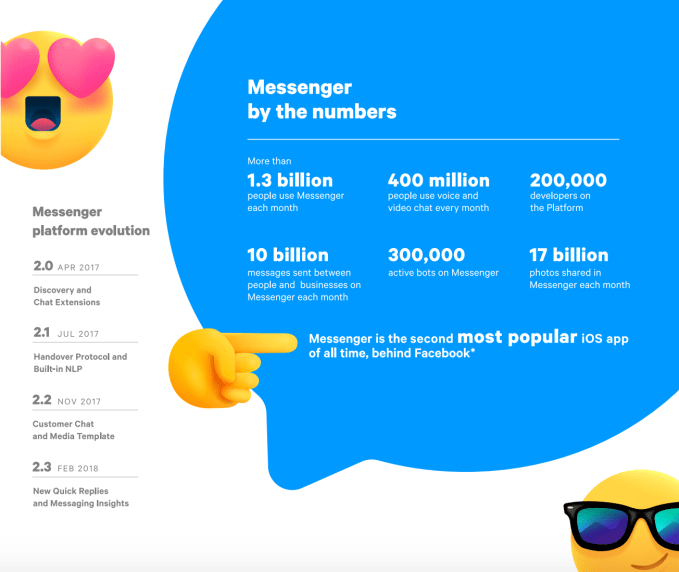
Facebook is starting to more aggressively monetize Messenger through inbox ads, and its now selling enterprise tools to brands on both Facebook and WhatsApp that let them pay to ping users. But Facebook risks its chat apps seeming annoying or intrusive if it packs in too many ads or allows too much Message spam. Users could stray to status quos like iMessage and Android Messages if it puts monetization above the user experience.
Dominating Snapchat
On Stories, Zuckerberg says Facebook is doing even better. Over 1 billion people use its Stories features across Facebook, Messenger, Instagram, and WhatsApp each day, compared to 186 million daily users on Stories inventor Snapchat as a whole. Stories are where the majority of Facebook sharing growth is happening, and Facebook Stories are gaining momentum after a slow and buggy start. That’s why Zuckerberg never mentioned Snapchat, and instead talk about YouTube as its primary competitor in video.
The problem is that creating attractive video ads, especially vertical full-screen ones for Stories, is beyond the capability of the long-tail on small businesses that have fueled Facebook’s News Feed ad revenue. Users often rapidly skip through Stories ads, and Facebook currently doesn’t offer unskippable ones like Snapchat. Many people don’t think to tap or swipe up to visit a link from a Story, or simply don’t want to lose their place in ways that didn’t happen on desktop or even mobile feed ads.
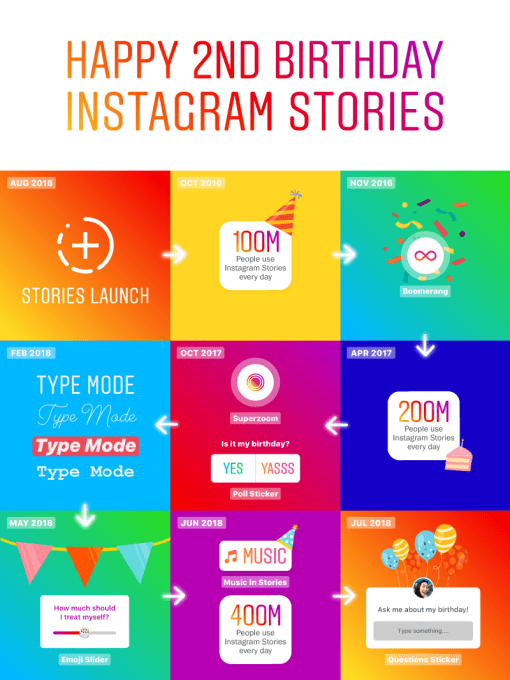
Chasing YouTube
Beyond Stories, Facebook salvaged its after-hours share price by discussing how it plans to show more video, and therefore more of its lucrative video ads. Back in January, Facebook admitted its Q4 user count had declined and revenue might stumble in part because it had decided to show people fewer viral videos that they watch passively. This came as part of its drive for Time Well Spent. But now, Zuckerberg says that Facebook has cracked the code for how to make passive video consumption a positive experience, so Facebook will lift some limits:
“People really want to watch a lot of video. To a large degree we’ve had to rate limit its growth, and we need to do the things so we can stop limiting it. The things that have caused us to limit it are on the one hand, when we see passive consumption of video displacing social interactions . . . We needed to figure out a way that video can grow but people can also keep on interacting and doing what they tell us that they uniquely want from Facebook. And now I think we’re starting to work through what the formula is going to be so we can take some of those rate limits off and let video grow at the rate that it wants to. I feel that that’s a very exciting opportunity ahead.”
Across Facebook’s other products, Zuckerberg noted that 800 million people now use Marketplace, its Jobs feature have helped people find 1 million jobs, and its birthday fundraisers have raised $300 million alone this year. But it will be teaching advertisers how to effectively create sponsored messages and Stories ads that will define whether Facebook’s revenue keeps growing.
from TechCrunch https://ift.tt/2AzU8H9
NASA’s prolific planet-hunter Kepler has finally earned its retirement
After nine years of service, half a million stars surveyed, and thousands of planets discovered around those stars, NASA’s astonishingly successful Kepler space telescope is finally taking a well-earned rest. Out of fuel but in a safe orbit, the spacecraft will drift through the solar system looking at nothing in particular as its immense trove of data continues to drive discoveries here on Earth.
Kepler launched in 2009 after, as is so often the case, decades of preparation, studies, and delays. Its mission, slated to last three and a half years, was to stare unblinkingly at one small patch of sky, watching each star for the minute changes that could indicate a planet briefly blocking its light.
The mission was successful beyond all expectations, and once the telescope was operational the data began producing exoplanets not by the dozen but by the thousand. And some came closer to an Earth analogue than astronomers had dared hope — suggesting rocky planets about our size aren’t all that rare. (Good news if we need to relocate.)
In 2014 the original mission was complete but Kepler was still going strong, largely due to robust construction and frugal fuel use. A second mission, dubbed K2, was approved, different from the first: instead of looking at a single patch for years, Kepler would shift its view to a new location every three months. Naturally the number of stars catalogued and observed skyrocketed.
Not all was well aboard, though: The craft lost one of its four reaction wheels, used to reorientate the craft against the pull of the sun and other forces, though fortunately it was designed to function without all of them. It was only the later failure of another wheel that essentially put a hard time limit on K2.
Without a reaction wheel to change its direction along all three axes, Kepler would have to burn precious fuel every time it needed to change its view or spin around to send data home.
Fuel or no fuel, Kepler was still churning out the data. Scientists verified and announced the existence of more than 1,200 more exoplanets in one go, while AI tools like Google’s were working to find others hidden in the noisy data.
But the end has come at last, and Kepler used the last of its reserves to maneuver into position to relay its final batch of data through the Deep Space Network. This, like the rest, will soon be available to citizen scientists and research organizations as well as NASA’s own teams.
As for the exoplanet hunt, that’s been taken up by the Transiting Exoplanet Survey Satellite, or TESS, launched earlier this year and now in operation. There’s every reason to think it’ll be as productive and inspiring as its predecessor and perhaps more so.
“When we started conceiving this mission 35 years ago we didn’t know of a single planet outside our solar system,” said Kepler’s founding principal investigator, William Borucki, since retired. “Now that we know planets are everywhere, Kepler has set us on a new course that’s full of promise for future generations to explore our galaxy.”
Having delivered its last package, Kepler has completed its final duty and now enters a rather pleasant retirement. Unlike Cassini, which ended up a new crater on Saturn’s surface (a sudden but glorious end), Kepler will simply fall into an Earth-like orbit some distance behind its home planet, likely to remain stable (barring the extraordinarily unlikely possibility of a cosmic debris strike) for many years to come.
We won’t hear from Kepler, and Kepler won’t hear from us. But it’s nice to think it’ll still be looking.
from TechCrunch https://ift.tt/2Q7AcRp
The hybrid cloud market just got a heck of a lot more compelling
Let’s start with a basic premise that the vast majority of the world’s workloads remain in private data centers. Cloud infrastructure vendors are working hard to shift those workloads, but technology always moves a lot slower than we think. That is the lens through which many cloud companies operate.
The idea that you operate both on prem and in the cloud with multiple vendors is the whole idea behind the notion of the hybrid cloud. It’s where companies like Microsoft, IBM, Dell and Oracle are placing their bets. These died-in-the-wool enterprise companies see their large customers making a slower slog to the cloud than you would imagine, and they want to provide them with the tools and technologies to manage across both worlds, while helping them shift when they are ready.
Cloud-native computing developed in part to provide a single management fabric across on prem and cloud, freeing IT from having two sets of tools and trying somehow to bridge the gap between the two worlds.
What every cloud vendor wants
Red Hat — you know, that company that was sold to IBM for $34 billion this week — has operated in this world. While most people think of the company as the one responsible for bringing Linux to the enterprise, over the last several years, it has been helping customers manage this transition and build applications that could live partly on prem and partly in the cloud.
As an example, it has built OpenShift, its version of Kubernetes. As CEO Jim Whitehurst told me last year, “Our hottest product is OpenShift. People talk about containers and they forget it’s a feature of Linux,” he said. That is an operating system that Red Hat knows a thing or two about.
With Red Hat in the fold, IBM can contend that being open source; they can build modern applications on top of open source tools and run them on IBM’s cloud or any of their competitors, a real hybrid approach.
Microsoft has a huge advantage here, of course, because it has a massive presence in the enterprise already. Many companies out there could be described as Microsoft shops, and for those companies moving from on prem Microsoft to cloud Microsoft represents a less daunting challenge than starting from scratch.
Oracle brings similar value with its core database products. Companies using Oracle databases — just about everyone — might find it easier to move that valuable data to Oracle’s cloud, although the numbers don’t suggest that’s necessarily happening (and Oracle has stopped breaking out its cloud revenue).
Dell, which spent $67 billion for EMC, making the Red Hat purchase pale by comparison, has been trying to pull together a hybrid solution by combining VMware, Pivotal and Dell/EMC hardware.
Cloud vendors reporting
You could argue that hybrid is a temporary state, that at some point, the vast majority of workloads will eventually be running in the cloud and the hybrid business as we know it today will continually shrink over time. We are certainly seeing cloud infrastructure revenue skyrocketing with no signs of slowing down as more workloads move to the cloud.
In their latest earnings reports, those who break out such things, the successful ones, reported growth in their cloud business. It’s important to note that these companies define cloud revenue in different ways, but you can see the trend is definitely up:
- AWS reported revenue of $6.7 billion in revenue for the quarter, up from $4.58 billion the previous year.
- Microsoft Intelligent Cloud, which incorporates things like Azure and server products and enterprise services, was at $8.6 billion, up from $6.9 billion.
- IBM Technology Services and Cloud Platforms, which includes infrastructure services, technical support services and integration software reported revenue of $8.6 billion, up from $8.5 billion the previous year.
- Others like Oracle and Google didn’t break out their cloud revenue.
Show me the money
All of this is to say, there is a lot of money on the table here and companies are moving more workloads at an increasingly rapid pace. You might also have noticed that IBM’s growth is flat compared to the others. Yesterday in a call with analysts and press, IBM CEO Ginni Rometty projected that revenue for the hybrid cloud (however you define that) could reach $1 trillion by 2020. Whether that number is exaggerated or not, there is clearly a significant amount of business here, and IBM might see it as a way out of its revenue problems, especially if they can leverage consulting/services along with it.
There is probably so much business that there is room for more than one winner, but if you asked before Sunday if IBM had a shot in this mix against its formidable competitors, especially those born in the cloud like AWS and Google, most probably wouldn’t have given them much chance.
When Red Hat eventually joins forces with IBM, it at least gives their sales teams a compelling argument, one that could get them into the conversation — and that is probably why they were willing to spend so much money to get it. It puts them back in the game, and after years of struggling, that is something. And in the process, it has stirred up the hybrid cloud market in a way we didn’t see coming last week before this deal.
from TechCrunch https://ift.tt/2RnCImY
Waymo, take the wheel: Self-driving cars go fully driverless on California roads
Self-driving startup Waymo, a Google spin-off owned by parent company Alphabet, has been granted the first permit in California to begin driverless testing on public roads. Yes, that means self-driving cars without a human behind the wheel will be cruising around California, beginning with a limited geographic area in Silicon Valley.
The company’s autonomous vehicles are a common sight on public roads in and around Google’s headquarters in Mountain View, California. The startup, which began as a moonshot project under X, has been testing on public roads for years now. But this permit, issued by the California Department of Motor Vehicles, allows Waymo to test these self-driving cars without a human test driver behind the wheel.
New California DMV regulations that took effect in April allow companies to apply for fully driverless testing within carefully defined limits. Waymo is the first to get approval. At least one other company is waiting in the wings.
Where you’ll find them
Waymo said its driverless test cars will initially hit the streets near its Silicon Valley headquarters, including parts of Mountain View, Sunnyvale, Los Altos, Los Altos Hills and Palo Alto. See the map below for the initial driverless launch.

Perhaps anticipating wariness from the public, Waymo emphasized that it knows this area “well.”
“Mountain View is home to more than a dozen autonomous vehicle companies, and has supported safe testing for years,” the company said in its announcement.
Waymo will eventually expand its driverless testing territory. Before it moves into a new area, Waymo said it will notify the new communities where this expansion will occur, and submit a request to the DMV.
Members of the public won’t be invited into these driverless cars just yet. However, Waymo is working toward that goal. The first driverless rides will be for Waymo employees. Waymo said it will eventually “create opportunities for members of the public to experience this technology,” similar to its early ride program in Arizona.
What Waymo is allowed to do
The driverless permit allows Waymo to test its driverless vehicles during the day and night on city streets, rural roads and highways with posted speed limits of up to 65 miles per hour. Waymo is also allowed to test in fog and light rain, conditions that the company said its vehicles can handle.
If one of its driverless vehicles encounters a situation it doesn’t understand it will come to “safe stop,” Waymo said, adding that it has well-established protocols that include contacting fleet and rider support.
The company announced earlier this month that its autonomous vehicles have driven 10 million miles on public roads in the United States since it began working on self-driving technology in 2009.
California is not the first state to test true driverless vehicles on public roads. Arizona gets that distinction. Waymo began testing self-driving Chrysler Pacifica Minivans in Phoenix suburbs, notably Chandler, in 2016. The company launched an early rider program in April 2017. Later that year, Waymo removed employees and passengers from its test fleet, sending empty self-driving minivans onto the streets of greater Phoenix.
from TechCrunch https://ift.tt/2yFYSK6
Coinbase is now worth more than all but three cryptocurrencies
With its shiny new $8 billion valuation, Coinbase is now worth more than all but the top three cryptocurrencies that trade on the platform.
That’s right, the only cryptocurrency assets that are worth more than the platform that trades them are Bitcoin, Ethereum and Ripple. Bitcoin Cash, the currency forked from Bitcoin, is a distant fourth in valuation at $7.3 billion.
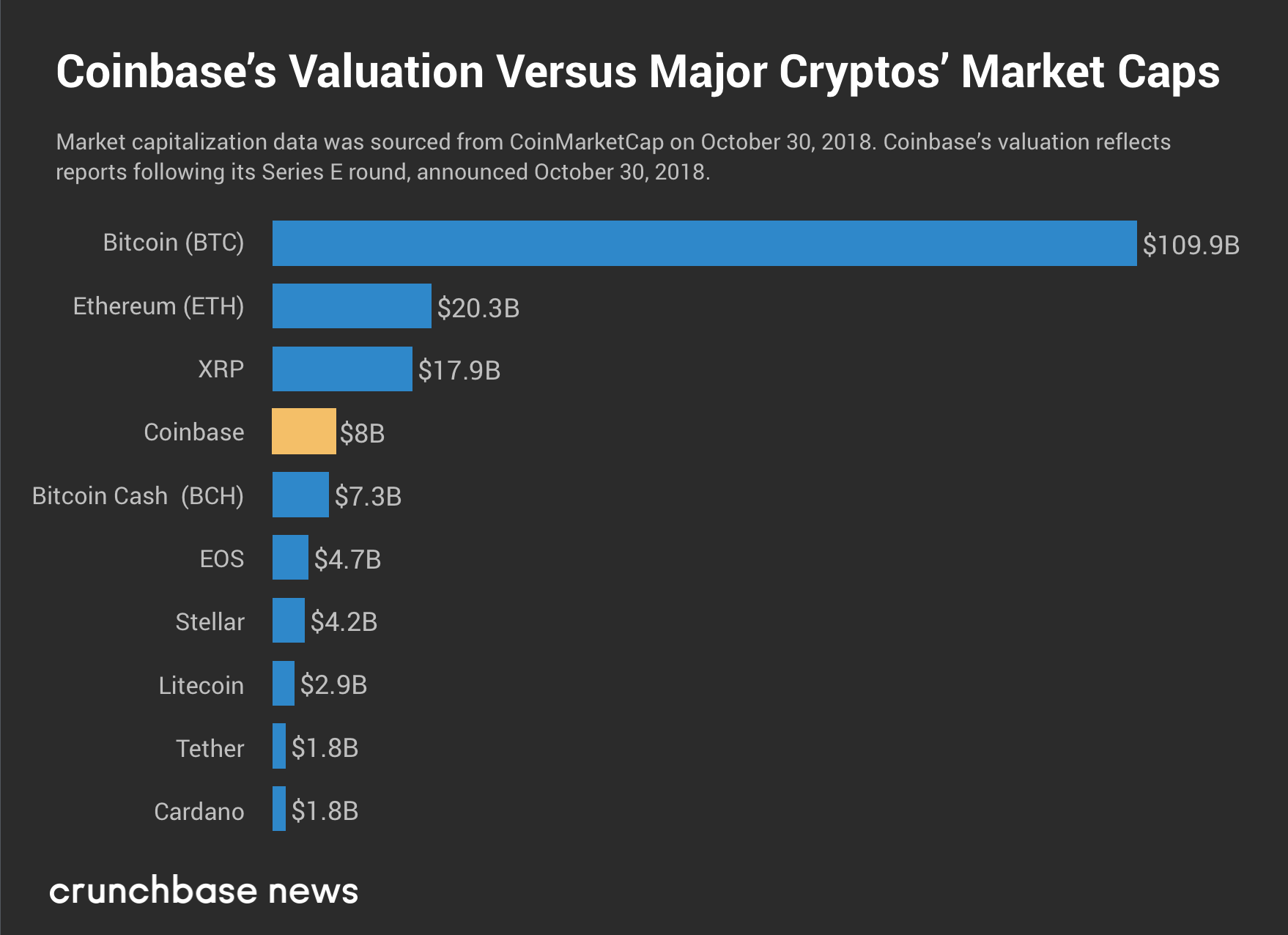
Coinbase’s Series E is nearly three times as much as the company raised in its Series D, and the fresh cash brings Coinbase’s total-capital-raised-to-date to over $520 million.
That’s a lot of money. Indeed, if Coinbase’s capital raised figured is compared to the market cap of the world’s various cryptocurrencies and other similar assets, it would rank around 20th.
But the bet for investors is, and should be, that if cryptocurrencies are indeed the next big idea in the ways that humans determine value, then Coinbase should be worth far more than any of the assets that trade on its exchange.
The fact that it’s neither indicates how much farther the company has to grow, or the limits of the thesis that cryptocurrencies will take over the world.
It shows that the wager on a particular crypto company is looking like a better investment than putting money to work in nearly any of the other crypto assets that are for sale. During the last few crypto booms, some investors said that it was probably simpler to just invest in various tokens instead of companies working on blockchains — faster returns and your money would be more liquid, to boot.
However, at least in the case of Coinbase, that wager likely wouldn’t have worked. Coinbase is also the company that every investor has wanted to invest in; it’s been a known winner for a while now, so its performance isn’t a huge surprise.
And now with $300 million, Coinbase is well-capitalized to survive either a market downturn (one will come eventually), and the current Crypto Interregnum.
Coinbase’s chief executive certainly thinks the market will grow. As we noted, Coinbase currently allows trading to just a handful of cryptocurrencies, but it has long harbored ambitions to expand beyond that.
Speaking at TechCrunch Disrupt SF in September, CEO Brian Armstrong revealed that he sees a future in which every cap table will have its own token. Based on that, he said he believes that Coinbase could host hundreds of tokens within “years” and even potentially “millions” in the future.
from TechCrunch https://ift.tt/2CPc7uU
Facebook shares climb despite Q3 user growth and revenue
After last quarter’s bloodbath earnings report that cut 20 percent from Facebook’s share price, the social network stumbled in Q3 2018, reaching 2.27 billion monthly users, up 37 million users or 1.79 percent — only slightly better than Q1’s slowest-ever growth rate of just 1.54 percent, and compared to an 2.29 billion Wall Street estimate. It added 24 million daily active users hit 1.49 billion, up 1.36 percent compared to Q1’s 1.44 percent, missing the 1.51 billion estimate.
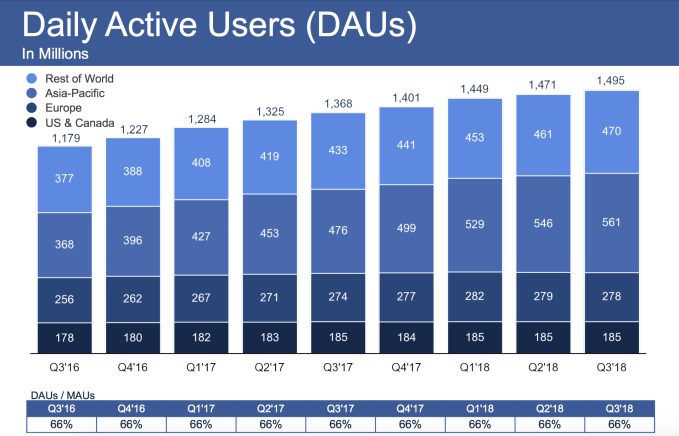
But the real growth story depends on its core US/Canada and Europe markets where Facebook saw zero growth and lost 1 million monthly users respectively last quarter. In Q3, Facebook added 1 million monthly users to reach 242 million in the US/Canada region, but held flat at 185 million dailies there. It lost 1 million users in Europe in both dailies and monthlies. Those markets make up over 70 percent of its revenue, which is why the slow growth and shrinkage is scaring Wall Street.
[Update: Facebook did make an adjustment to its user count measurements this quarter to disclude some misclassified activity, reducing counts by 0.3 percent to 1 percent. Notably, without this correction its daily US & Canada count would have grown by 1 million instead of staying flat this quarter, its daily Europe users would have grown 5 million instead of shrinking 1 million, and its monthly Europe count would have grown 1 million instead of shrinking by 1 million.]
Revenue Slows Alongside Western User Growth
As for Facebook’s business, the company earned $13.73 in revenue, compared to Refinitiv’s consensus estimate of $13.78 billion, and saw $1.76 EPS compared to an estimate of $1.47, making for a mixed report. Revenue was up 33 percent year-over-year, but that’s much slower than the 49 percent YOY gain it had a year ago, and the 59 percent it had in Q3 2016.
Facebook blamed foreign exchange headwings for $159 million in Q3, which was the difference between its miss and a beat on revenue. Mobile accounted for 92 percent of Facebook’s ad revenue, up from 91 percent last quarter, so when you think of the social network, be sure you’re not thinking of a desktop website.
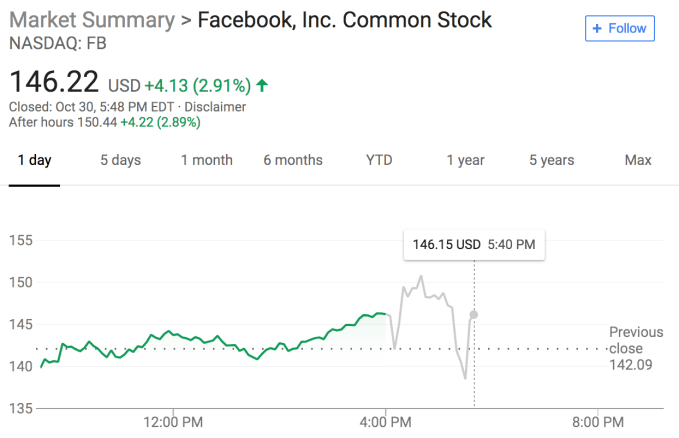
Long-term, Facebook can’t exchange growth in its core markets for expansion in Asia-Pacific and the developing world. Facebook average revenue per user worldwide is $6.09, but the regional differences are stark. It rakes in $27.61 per users in the US and Canada, and $8.82 in Europe, but just $2.67 in Asia-Pacific and $1.82 in the Rest Of World region. In fact, ARPU dropped 4 percent in the Rest Of World, indicating users there may be spending fewer minutes per day browsing the News Feed and seeing ads.
A Wild Earnings Call
Facebook’s share price closed at $146.22 before earnings were released, still massively down from its $217 peak for before it announced user growth troubles and slowing revenue growth in Q2’s earnings report. Facebook shares climbed 2 percent upon the announcement of earnings, in part thanks to Facebook pulling in $5.14 billion in profit and it adding 1 million users in the North American region after going flat last quarter, but oscillated wildly throughout the earnings call.
There, Zuckerberg stressed that sharing is shifting towards private chat where users send 100 billion messages on Facebook’s apps per day, and Stories where people share 1 billion slideshows per day. He cited Apple’s iMessage and YouTube, but not Snapchat, as Facebook’s big competitors going forward. Those comments drove shares down 5 percent, reversing early gains. But later, he noted that Facebook believes it’s found the right formula for showing people more meaningful passive video, so Facebook will lift some restrictions on how many lucrative video ads it showed. That pushed Facebook’s share back to 3 percent up in after-hours trading.
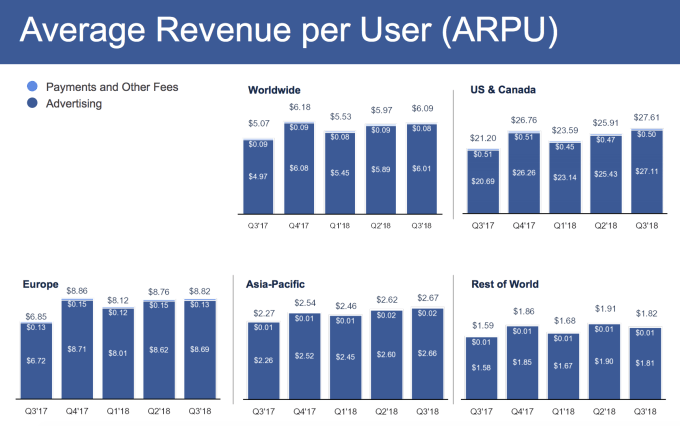
Facebook hoped to show that its business can keep growing even as amidst a wide range of troubles. It did note that “more than 2.6 billion people now use Facebook, WhatsApp, Instagram, or Messenger each month” compared to 2.5 billion last quarter. It also revealed another new stat: “more than 2 billion people use at least one of our Family of services every day on average.” The goal of both of these stats is to distract from Facebook’s own slow growth by reminding people that some of those users who leave are going to its other properties.
But still, the company’s revenues and profits have been overshadowed by the non-stop parade of scandals ranging from election interference to its biggest security breach ever. Next quarter we’ll see if the breach scared users away or if Facebook logging them out for safety led some to never log back in.
Let’s remember that the company should be lauded for investing so much to beat back fake news and election interference, and cutting back on viral videos and clickbait that juice engagement but are terrible for user well-being and society. It doubled its security and content moderation staff from 10,000 to 20,000 this year. They now make up over half the company, as headcount grew 45 percent year-over-year to 33,606. Twitter’s shares soared on last week’s profitable Q3 earnings report, but it’s made no such measureable commitment to fight harassment and misinformation. Facebook is still constantly screwing up when it comes to privacy and security, but at least it’s putting its ample money where its mouth is.
from TechCrunch https://ift.tt/2AAZXnX
To actually change the world, Big Tech needs to grow up
“Fierce competitor” is one of the biggest, and most culturally ingrained, compliments that exists in sports. The same is true in the technology world. However, as competitors originating from outside of Silicon Valley rise, so do the stakes for previously unchallenged tech firms, like Uber, Facebook and Google, to enter new markets responsibly. Companies that were once earnest startups helmed by say-anything, hoodie-wearing twenty-somethings are now big corporations with boards, stakeholders and tremendous impacts on society.
They need to start acting like it.
Amid mounting government and public pressures, tech firms famous for pushing far beyond boundaries now need to play by the rules when they enter new cities and towns. They now have to embrace more humble methods of conducting business and admit defeat when younger upstarts create better, faster innovations. Freshly relocated tech companies need to respect the indigenous innovation scene in a chosen location — not simply conduct headquarter operations somewhere else. They need to bring to every new market entrepreneurial thinking, jobs and a willingness to develop strong connections with public and private sector leaders.
The good news is that it’s not too late for tech giants to learn to be responsible, self-aware competitors. However, a few central questions need to be answered: Will big tech companies begin to bring more to cities than they take? Will they become responsible community partners building smart technologies in a way that respects new market values — especially around diversity, privacy and respect for people’s data? Or will they use their heft to out-maneuver municipal authorities, outbid local startups for engineering talent and ship intellectual property and data back to headquarters?
As Uber’s rebrand takes hold, for instance, CEO Dara Khosrowshahi needs to guide his organization toward working with municipal and community leaders — rather than coexisting with them at best. He and his team need to deepen their understanding of regulatory environments at the city level, play within the rules governing specific places and work to encourage homegrown tech talent in Uber’s new markets to pursue career opportunities with international reach. Uber needs to back up the company’s newly rolled out softer, safer image with concrete efforts to complement the innovation ecosystems already flourishing in cities outside of its hometown of San Francisco — and compete collaboratively in markets around the world.
Other tech giant founders, CEOs and executive teams around the world need to follow suit — regardless of whether actual suits are involved.
Success requires a balance of fierce competitiveness and humble respect.
Indeed, there’s a right way for tech companies to contribute to local causes and be good corporate citizens in general. The process starts with bigger tech companies establishing information exchanges with new communities that build trust and prioritize learning. After establishing operations and understanding the needs of communities surrounding them, tech companies need to prove their genuine interest in local innovation ecosystems. One way to do this is by donating money to a relevant charity or nonprofit organization that provides useful skill development to underserved communities.
Another, more humbling, option for tech giants is to invest in native startups building innovations that help them improve corporate citizenship — a technology that reduces their global carbon footprint, for example — and complement their own capabilities.
I am a serial entrepreneur and optimist. That’s why I believe that technology companies like Uber, Google and Facebook have a unique opportunity to deliver more than monetary investment into communities around the world. They need to assume responsibility for advancing innovation and talent upon arrival in a new city — and actively build programs that bridge location-specific digital, skill and transportation gaps.
Tech giants need to work with government and community peers to connect with local competitors already building the next generation of technology platforms. Success requires a balance of fierce competitiveness and humble respect. The entry of a tech giant to a new place should inspire connectivity, understanding and competition that lifts a community’s entire innovation ecosystem.
from TechCrunch https://ift.tt/2Sx0fmK
Can Apple finish 2018 on a high note? We’ll find out Thursday
Apple (NASDAQ: APPL) has had a great 2018.
Even as the other FAANG stocks slumped, the trillion-dollar electronics company has continually satisfied Wall Street with quarter-over-quarter revenue growth. But will Apple’s momentum continue after it reports its fourth-quarter earnings on Thursday?
The consensus, so far, is yes. Apple is expected to post revenue of $61.43 billion (earnings per share of $2.78), an increase of 17 percent year-over-year and GAAP EPS of $2.78, according to analysts polled by FactSet. Investors will be paying close attention to iPhone unit sales, which account for the majority of Apple’s revenue, as well as Mac sales, which accounted for roughly 10 percent of the company’s revenue in Q3.
The company reported its Q3 earnings on July 31, posting $53.3 billion in revenue, its best June quarter ever and fourth consecutive quarter of double-digit revenue growth, the company said.
At today’s hardware event in Brooklyn, Apple’s chief executive officer Tim Cook shared that the company’s Mac business had grown to 100 million monthly active users — a big accomplishment for the nearly 10-year-old product. Cook also showcased the new MacBook Air and introduced the new iPad Pro and Mac Mini.
Not even Lana Del Rey’s surprise performance at the event was enough to rile up Wall Street. Apple’s stock was unreactive today, as is typically the case with hardware spectacles like these. Apple ultimately closed up about .5 percent. That’s a better outcome than its last hardware event in September, which despite the highly anticipated announcements of the iPhone XS and Apple Watch Series 4, forced the company’s stock down about 1.2 percent on the news.
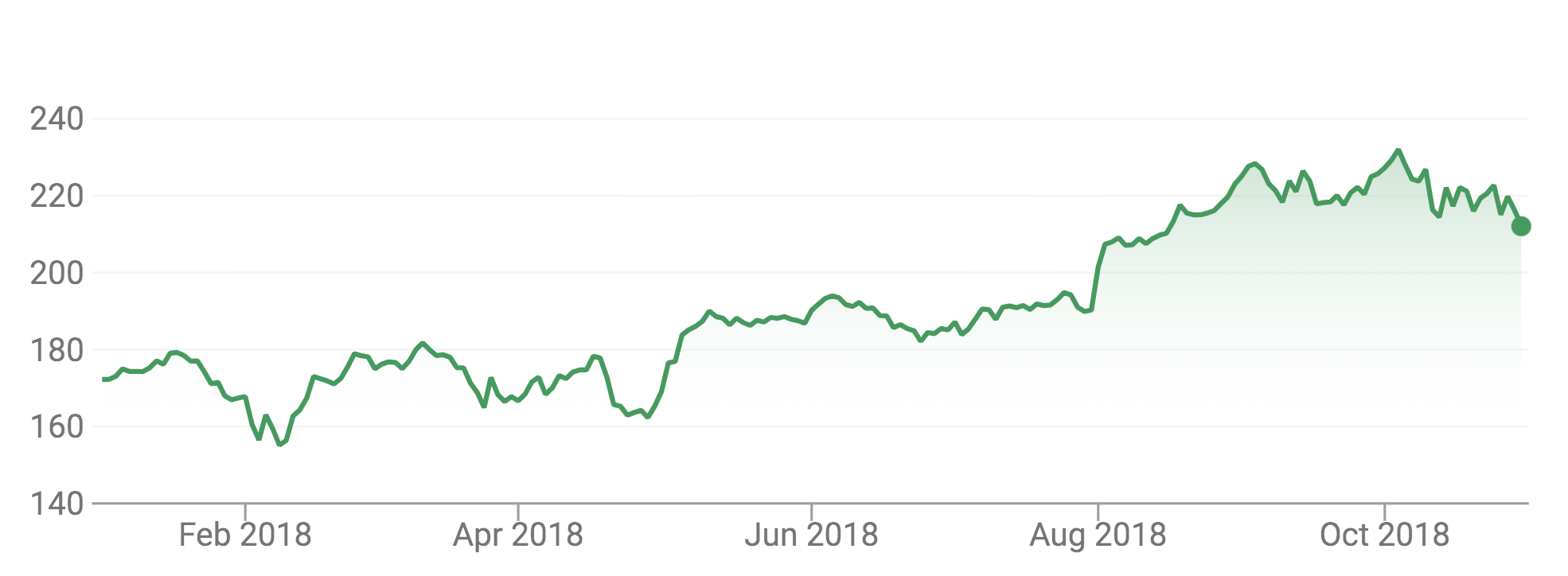
Apple’s stock performance year to date
Year to date, Apple’s stock has risen more than 30 percent from a February low of $155 per share to an October high of $229.
If it fails to meet analyst expectations on Thursday, it’s bad news for the stock market: “Apple is the last domino standing,” Market Watch wrote earlier today. “Its FAANG brethren have all crashed, even the mighty Amazon, which has slumped about 25% from all-time highs.”
If you missed today’s event, we live-blogged the whole thing here and detailed all the new hardware here.
from TechCrunch https://ift.tt/2OWNEuS
WeWork-owned Meetup brings on David Siegel as CEO
Late this past summer, Meetup founder and CEO Scott Heiferman moved into the chairman position, leaving the CEO role vacant. Today, Meetup has announced that David Siegel will be taking the helm at the 15-year-old company.
Siegel hails from Investopedia, where he served as CEO for three years, tripling the company’s revenue and doubling its traffic in that period. Before his time at Investopedia, Siegel was president of Seeking Alpha, overseeing U.S.-based functions including sales, marketing, product and bizdev.
At the end of 2017, co-working behemoth WeWork acquired Meetup for a reported $200 million. Meetup’s entire premise is based on the idea of community — use the internet to get people off the internet and talking in real life. That’s a central theme in the WeWork strategy.
Here’s what Siegel had to say about the transition:
In a world where technology often drives greater distances between people, Meetup uses technology to bring real, in-person and life-changing connections to millions of people globally. Together with WeWork, Meetup is reinventing how people work, live, learn, play, and create community every day. I am thrilled to be a be a part of this incredibly exciting venture to bring more people together.
Meetup currently has more than 40 million members, 320,000 Meetup groups and facilitates 12,000 meetups per day around the world.
from TechCrunch https://ift.tt/2COrHH0
Even Financial acquires Birch Finance, a credit card rewards startup
On the heels of a funding round to the tune of $18.8 million, Even Financial has acquired Birch Finance for an undisclosed sum.
Even offers products like a pre-approval API, real-time pricing, machine learning optimization, a product comparison and recommendation engine for consumers and more. Birch Finance, a TC Startup Battlefield alum that raised $1 million earlier this year, aims to help people make the most of the credit cards in their wallets by telling them which cards will earn them the most points. It works by analyzing your transaction history to identify missed rewards opportunities. Even’s plan with this acquisition is for Even to expand its offerings within the credit card space.
“The credit card market continues to expand with millions of consumers opening up hundreds of different types of credit cards every year for countless reasons,” Phillip Rosen said in a statement. “Birch already has one of the largest credit card databases and their technology perfectly complements our existing platform as we expand our offering to the credit card space. This acquisition will allow our partners to optimize the process of getting the right cards to the right consumers.”
Even’s slate of partners includes Credit.com, a personal loans marketplace, The Penny Hoarder and Transunion. With the Birch team on board, Even will enable its partners to save on consumer acquisition while also scaling its credit card recommendation platform. At Even, Birch co-founder Alex Cohen will serve as senior director of the credit card marketplace.
In a statement, Cohen said, “We saw a clear synergy with Even’s business strategy and growth plans, and I’m thrilled to join Even’s team as we expand and scale our offerings into new areas.”
from TechCrunch https://ift.tt/2qmf1Qp
Google Pixel 3 XL users are getting twice the notch, thanks to a bug
Over the past two years, the notch moved from anomaly to fact of life, and no company has proven itself more pro-notch than Google. From its embrace of #notchlife in Android Pie to the downright gigantic one found up top on the Pixel 3 XL, Google’s really notchin’ it up.
In fact, as noted by Android Police, the Pixel 3 XL has a notch so nice, Google’s delivering it twice. A number of owners have reported an admittedly hilarious bug that’s causing the massive handset to double up on the notch, with a second cutout appearing on the side of the device.
So my Pixel randomly grew another notch today.
https://t.co/c6Pff9MVmW pic.twitter.com/ugjfLmCkDZ
— UrAvgConsumer (@UrAvgConsumer) October 24, 2018
Google has acknowledged (acknotchleged?) the issue and noted that it’s working on a fix, which should be coming soon. The company hasn’t offered a reason behind the issue, but it appears to stem from Pie’s built-in notch feature, and likely has something to do with how the background adjusts when the handset changes from portrait to landscape mode.
It seems even in 2018, that’s a notch too far.
from TechCrunch https://ift.tt/2qiiaAv
How to play Googles first multiplayer, interactive Halloween 2018 Doodle game
 Google is celebrating Halloween 2018 with its first ever interactive, multiplayer Google Doodle game called Trick-or-Treat: The Great Ghoul Duel! The Halloween themed game is hosted on Google’s Cloud platform and players around the world can team up randomly and join a match or host their own game with up to seven friends and family members via a custom invitation link. In the game, you play as a Green or a Purple Ghost and your job is to collect souls. Spooky music plays out as you dash to collect as many souls or spirit flames as you can and deposit them to your base. Players can also steal souls from other members of the opposing team and gain special ghostly powers like speed boosts, night vision and more. Players can share personal superlatives awarded to them at the end of the match based on their performances. Google implemented this special Halloween Doodle game with the help of Open Match, a highly-scalable, open source matchmaking framework cofounded by Google Cloud and Unity. Open Match is designed to allow game developers to reuse a common matchmaker framework. It includes three core components: a frontend API for game clients, a backend API for game servers, and an orchestrator that runs game-specific custom matchmaking logic. But that’s TMI for Halloween so head on over here to play Google’s Trick-or-Treat: The Great Ghoul Duel!
Google is celebrating Halloween 2018 with its first ever interactive, multiplayer Google Doodle game called Trick-or-Treat: The Great Ghoul Duel! The Halloween themed game is hosted on Google’s Cloud platform and players around the world can team up randomly and join a match or host their own game with up to seven friends and family members via a custom invitation link. In the game, you play as a Green or a Purple Ghost and your job is to collect souls. Spooky music plays out as you dash to collect as many souls or spirit flames as you can and deposit them to your base. Players can also steal souls from other members of the opposing team and gain special ghostly powers like speed boosts, night vision and more. Players can share personal superlatives awarded to them at the end of the match based on their performances. Google implemented this special Halloween Doodle game with the help of Open Match, a highly-scalable, open source matchmaking framework cofounded by Google Cloud and Unity. Open Match is designed to allow game developers to reuse a common matchmaker framework. It includes three core components: a frontend API for game clients, a backend API for game servers, and an orchestrator that runs game-specific custom matchmaking logic. But that’s TMI for Halloween so head on over here to play Google’s Trick-or-Treat: The Great Ghoul Duel!from Latest Technology News https://ift.tt/2zfrpWd
Google Pixel 3 XL notch bug gives the phone two display notches, fix coming soon
 If you thought Google Pixel 3 XL’s big and bulky notch was enough to put you off, you were wrong. While several handset users (hilariously) reported that their devices grew another notch on the sides of the display, some were really annoyed at the glitch. The virtual notch was not seen at one particular position, and while some said it appeared on the left edge, some side the second notch grew on the right side. Luckily, Google is aware of the problem and says that it will fix it soon. The problem was first reported by UrAvgConsumer who posted a tweet on October 25. Although there is no exact explanation of what caused this glitch, according to Slashgear, there is a possibility that a rogue developer settings could have been enabled. This might have confused the auto-rotate on the phone possibly causing the faux notch stuck in the wrong place. The tech news platform says that Android offers coders the ability to add a virtual notch to their phone so that they can test under development apps to see how they work when run on a device with a notch on the screen. According to AndroidPolice, Google reached out to them to let the publication know that “not only is the company aware of this highly anomalous behaviour, but that a fix should be coming soon”. Google launched the third generation of Pixel smartphones on October 9. In our review, we listed the notch as one of the cons of the smartphone. The notch contains the earpiece which doubles up as one half of the stereo speaker setup, neatly sandwiched between two front-facing cameras.
If you thought Google Pixel 3 XL’s big and bulky notch was enough to put you off, you were wrong. While several handset users (hilariously) reported that their devices grew another notch on the sides of the display, some were really annoyed at the glitch. The virtual notch was not seen at one particular position, and while some said it appeared on the left edge, some side the second notch grew on the right side. Luckily, Google is aware of the problem and says that it will fix it soon. The problem was first reported by UrAvgConsumer who posted a tweet on October 25. Although there is no exact explanation of what caused this glitch, according to Slashgear, there is a possibility that a rogue developer settings could have been enabled. This might have confused the auto-rotate on the phone possibly causing the faux notch stuck in the wrong place. The tech news platform says that Android offers coders the ability to add a virtual notch to their phone so that they can test under development apps to see how they work when run on a device with a notch on the screen. According to AndroidPolice, Google reached out to them to let the publication know that “not only is the company aware of this highly anomalous behaviour, but that a fix should be coming soon”. Google launched the third generation of Pixel smartphones on October 9. In our review, we listed the notch as one of the cons of the smartphone. The notch contains the earpiece which doubles up as one half of the stereo speaker setup, neatly sandwiched between two front-facing cameras.from Latest Technology News https://ift.tt/2Sykpwr
Microsoft Office for macOS Mojave is getting a dark mode
 Microsoft Office 365 for the Mac is getting a dark mode on macOS Mojave. The information comes from Microsoft's own Akshay Bakshi, a Product Manager for Microsoft on Twitter. He tweets, “Look closely at the Pictures icon. Office running on macOS Mojave in Dark Mode.” If you are a part of office insider, you will be able to access this feature as early as next week. As an office insider, users will get previews of the updates coming to MS office, like this upcoming dark mode for Mac. Insiders will also be able to give feedback to Microsoft about the features. It also seems that the dark mode will be limited to Office 365 subscribers. MacOS Mojave already has a dark mode and the dark mode in MS Office will compliment this if you are one that is using dark mode in Apple’s latest desktop and laptop OS. Once testing of the new features is complete, it will roll out to Office 365 users. There is no official information whether dark mode will make its way to any other versions of Office for Mac as of now. Microsoft also introduced a dark mode in File Explorer in the October update for Windows 10. You can read more about the October Windows 10 update here.
Microsoft Office 365 for the Mac is getting a dark mode on macOS Mojave. The information comes from Microsoft's own Akshay Bakshi, a Product Manager for Microsoft on Twitter. He tweets, “Look closely at the Pictures icon. Office running on macOS Mojave in Dark Mode.” If you are a part of office insider, you will be able to access this feature as early as next week. As an office insider, users will get previews of the updates coming to MS office, like this upcoming dark mode for Mac. Insiders will also be able to give feedback to Microsoft about the features. It also seems that the dark mode will be limited to Office 365 subscribers. MacOS Mojave already has a dark mode and the dark mode in MS Office will compliment this if you are one that is using dark mode in Apple’s latest desktop and laptop OS. Once testing of the new features is complete, it will roll out to Office 365 users. There is no official information whether dark mode will make its way to any other versions of Office for Mac as of now. Microsoft also introduced a dark mode in File Explorer in the October update for Windows 10. You can read more about the October Windows 10 update here.from Latest Technology News https://ift.tt/2zgkex9
OnePlus 6T gets first software update with OxygenOS 904 improving Nightscape, adding November security patch
 It has been two days since the OnePlus 6T became official globally and just a few hours since its India price was announced and the company is already rolling out a software update to the phone. OnePlus is now seeding OxygenOS 9.0.4 update to the OnePlus 6T, which brings improvements to Nightscape in camera and also updates the phone’s Android security patch to November, which the OnePlus 6 also received recently through Open Beta 6. We still don't know what the November patch fixes, because Google is yet to release the November Security Bulletins. Nightscape on the OnePlus 6T is nothing but the pro-mode sprinkled with some computational photography. When shooting in low light, the camera bumps up the ISO and slows down the shutter speed. The update was originally spotted by HDBlog and apart from improvements to Nightscape and an updated security patch, it also brings improvements to Screen Unlock, come new navigation gestures, optimised standby power consumption and some general bug fixes. OnePlus 6T’s camera also gets added studio lighting to enhance face contour. The OxygenOS 9.0.4 update is rolling out right now and users may receive it in a phased manner. The OnePlus 6T is priced starting at Rs 37,999 for 6GB+128GB variant while the 8GB+128GB variant will retail for Rs 41,999. The top most variant with 8GB RAM and 256GB storage will be available for Rs Rs 45,999. You can read more about its India availability and buying offers here.
It has been two days since the OnePlus 6T became official globally and just a few hours since its India price was announced and the company is already rolling out a software update to the phone. OnePlus is now seeding OxygenOS 9.0.4 update to the OnePlus 6T, which brings improvements to Nightscape in camera and also updates the phone’s Android security patch to November, which the OnePlus 6 also received recently through Open Beta 6. We still don't know what the November patch fixes, because Google is yet to release the November Security Bulletins. Nightscape on the OnePlus 6T is nothing but the pro-mode sprinkled with some computational photography. When shooting in low light, the camera bumps up the ISO and slows down the shutter speed. The update was originally spotted by HDBlog and apart from improvements to Nightscape and an updated security patch, it also brings improvements to Screen Unlock, come new navigation gestures, optimised standby power consumption and some general bug fixes. OnePlus 6T’s camera also gets added studio lighting to enhance face contour. The OxygenOS 9.0.4 update is rolling out right now and users may receive it in a phased manner. The OnePlus 6T is priced starting at Rs 37,999 for 6GB+128GB variant while the 8GB+128GB variant will retail for Rs 41,999. The top most variant with 8GB RAM and 256GB storage will be available for Rs Rs 45,999. You can read more about its India availability and buying offers here.from Latest Technology News https://ift.tt/2Sz4vSx
Apple MacBook Air, iPad Pro and Mac Mini India price and availability announced
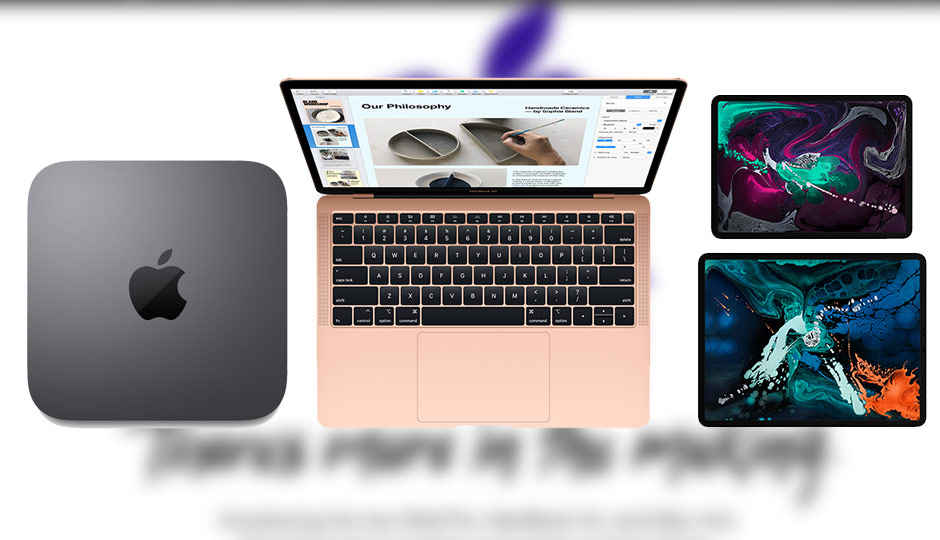 Apple just wrapped up an eventful evening in New York, where the company announced the new iPad Pro, an updated Mac Mini and a refresh of the universally loved MacBook Air. All three products have received significant upgrades from their predecessors, and just as much as everyone was waiting to hear what Apple had to announce, now we also have the price of the devices in India. iPad Pro The new iPad Pro that comes in 11-inch and 12.5-inch variants and is powered by the new A12X Bionic chip is the device for creative professionals. It comes with an all-new Apple Pencil and for the first time ever, a USB-C port on an Apple portable device. It is nice to see Apple finally embrace a universal port standard for their tablet. You can read everything about the new iPad Pro models in our in-depth story here. Additionally, here are the prices for the new iPad Pro Models in India. There is no official date of availability yet, but given that Apple has been treating India as a market of great importance, we expect that the new iPad Pro models will be available sooner rather than later. 11-inch iPad Pro (Wi-Fi) – Starts at Rs 71,900 11-inch iPad Pro (Wi-Fi + Cellular) – Starts at Rs 85,900 12.9-inch iPad Pro (Wi-Fi) - Starts at Rs 89,900 12.9-inch iPad Pro (Wi-Fi + Cellular) – Starts at Rs 1,03,900 Second Generation Apple Pencil – Rs 10,900 Smart Keyboard Folio for the new iPad Pro (11-inch) – Rs 15,900 Smart Keyboard Folio for the new iPad Pro (12.5-inch) – Rs 17,900 Smart Folio for iPad Pro (11-inch) – Rs 7,500 Smart Folio for iPad Pro (12.5-inch) – Rs 9,900 MacBook Air The most beloved MacBook has finally received a refresh after three years and brought it up to speed with 2018. Featuring a far slimmer bezel than before, a Retina Display, Intel’s latest 8th generation Core i5 processor and up to 16GB of RAM, the MacBook Air packs quite a lot and still manages to be lighter than before. You can read all about the new MacBook Air in our in-depth story here. For those wondering, the new MacBook Air price in India is set to start at Rs 1,14,900 for the base variant. The new MacBook Air will be available in India starting November 7. Unfortunately, the Indian market will only get two variants of the MacBook Air, both with 8GB RAM, but a choice of 128GB or 256GB storage. Mac Mini The Mac Mini has also been updated by Apple to brand new specs, making this little box nothing short of a theoretical workhorse. The Mac Mini will come in a choice of Intel’s Core i3 or Core i5 processors and can support RAM all the way up to 64GB. If you’re curious about all that the new Mac mini has to offer, we have a full breakdown here. The Mac Mini will be available in India starting November 7 and will start at Rs 75,900 for the base variant which comes with an Intel Core i3 processor and 8GB RAM. You can configure the Mac Mini with up to an Intel Core i5 processor and 256GB storage, however, you will be limited to 8GB RAM. MacBook Pro Apple also announced that their MacBook Pro will also be available with the Radeon Pro Vega graphics, which promises to deliver up to 60 percent better graphics performance. This configuration is not listed on Apple India’s website and does not have a price tag attached to it yet, but you can order the new variant through Apple authorized retailers starting November 14.
Apple just wrapped up an eventful evening in New York, where the company announced the new iPad Pro, an updated Mac Mini and a refresh of the universally loved MacBook Air. All three products have received significant upgrades from their predecessors, and just as much as everyone was waiting to hear what Apple had to announce, now we also have the price of the devices in India. iPad Pro The new iPad Pro that comes in 11-inch and 12.5-inch variants and is powered by the new A12X Bionic chip is the device for creative professionals. It comes with an all-new Apple Pencil and for the first time ever, a USB-C port on an Apple portable device. It is nice to see Apple finally embrace a universal port standard for their tablet. You can read everything about the new iPad Pro models in our in-depth story here. Additionally, here are the prices for the new iPad Pro Models in India. There is no official date of availability yet, but given that Apple has been treating India as a market of great importance, we expect that the new iPad Pro models will be available sooner rather than later. 11-inch iPad Pro (Wi-Fi) – Starts at Rs 71,900 11-inch iPad Pro (Wi-Fi + Cellular) – Starts at Rs 85,900 12.9-inch iPad Pro (Wi-Fi) - Starts at Rs 89,900 12.9-inch iPad Pro (Wi-Fi + Cellular) – Starts at Rs 1,03,900 Second Generation Apple Pencil – Rs 10,900 Smart Keyboard Folio for the new iPad Pro (11-inch) – Rs 15,900 Smart Keyboard Folio for the new iPad Pro (12.5-inch) – Rs 17,900 Smart Folio for iPad Pro (11-inch) – Rs 7,500 Smart Folio for iPad Pro (12.5-inch) – Rs 9,900 MacBook Air The most beloved MacBook has finally received a refresh after three years and brought it up to speed with 2018. Featuring a far slimmer bezel than before, a Retina Display, Intel’s latest 8th generation Core i5 processor and up to 16GB of RAM, the MacBook Air packs quite a lot and still manages to be lighter than before. You can read all about the new MacBook Air in our in-depth story here. For those wondering, the new MacBook Air price in India is set to start at Rs 1,14,900 for the base variant. The new MacBook Air will be available in India starting November 7. Unfortunately, the Indian market will only get two variants of the MacBook Air, both with 8GB RAM, but a choice of 128GB or 256GB storage. Mac Mini The Mac Mini has also been updated by Apple to brand new specs, making this little box nothing short of a theoretical workhorse. The Mac Mini will come in a choice of Intel’s Core i3 or Core i5 processors and can support RAM all the way up to 64GB. If you’re curious about all that the new Mac mini has to offer, we have a full breakdown here. The Mac Mini will be available in India starting November 7 and will start at Rs 75,900 for the base variant which comes with an Intel Core i3 processor and 8GB RAM. You can configure the Mac Mini with up to an Intel Core i5 processor and 256GB storage, however, you will be limited to 8GB RAM. MacBook Pro Apple also announced that their MacBook Pro will also be available with the Radeon Pro Vega graphics, which promises to deliver up to 60 percent better graphics performance. This configuration is not listed on Apple India’s website and does not have a price tag attached to it yet, but you can order the new variant through Apple authorized retailers starting November 14. from Latest Technology News https://ift.tt/2EVzhlV
Apple announces all-new 11-inch and 129-inch Pad Pro: Specs, features, price, availability and everything else you need to know
 Apple has announced two new iPad Pro tablets. The new iPads will be available in the US starting November 7. There is no information available on when the new iPads will come to India or an India pricing. The design of the new iPad Pro has changed to be more angular compared to the rounded edges found on the previous generation iPads. Speaking of the previous generation iPad, the 10.5-inch iPad Pro will continue to sell in the market. The new iPad Pros are a 5.9mm thick and the 11-inch iPad pro weighs 468 grams, whereas the 12.9-inch iPad Pro weighs 631 grams. As the rumour mills suggested, the new iPads have forgone the home button in favour of Face ID. This is how the 11-inch iPad Pro manages to get an 11-inch display in the 10.5-inch iPad Pro's form factor. The Pro still has 4 speakers and this time the devices have magnets all around to hold and charge the new Apple Pencil. For connectivity Apple removed the lightning cable in favour of USB-C, giving users the ability to connect the iPad to a host of devices such a 5K display. The new iPad Pros can also be used as power banks to charge other devices. Speaking of the display, the 11-inch iPad Pro has a resolution of 2388x1668 pixels giving it a pixel density of 264ppi. The 12.9-inch iPad Pro has a 2732x2048 pixel resolution giving it a resolution of 264ppi. Both the tablets have Apple’s True Tone display, fingerprint-resistant oleophobic coating and 600 nits of brightness. The displays of the new iPads support 120Hz refresh rate. Under the hood, the new iPad are powered by the A12X Bionic chip. The new chip has more than 12 billion transistors. It is an 8-core CPU with 4 performance cores and 4 efficiency cores. Apple says that the new A12X Bionic gives 35% faster single core performance than its predecessor whereas the multicore performance is up to 90 percent faster. During the launch keynote Apple even said that the chip is faster than 92% of portable PCs sold in the last 12 months. On the graphics front, the A12X has a new 7 core GPU, which Apple says has twice the performance of its predecessor. To put things into perspective, the graphics of the new iPad Pro is 1000x faster than the 1st gen iPad. During the keynote, Apple said that the new iPads deliver Xbox One S level graphics performance. This is something we can’t wait to get our hands on and see. When it comes to battery, Apple hasn’t announced the mAh of the new iPads, but it does claim up to 10 hours of surfing the web on Wi-Fi, watching video, or listening to music Coming to the camera, like we mentioned above, the new iPad Pros will now support Face ID and for this it has Apples True Depth front facing camera. The front facing camera is a 7MP shooter, whereas the rear camera is a 12MP one with an f/1.8 aperture lens. The camera can record video at a maximum of 4K at 60fps with slow mo at 1080p at 120 fps and 720p at 240 fps. The tablets also have Bluetooth 5 under the hood. Moving on, Apple also announced the second-generation Apple Pencil. The new pencil magnetically attaches to the iPad (finally) and while its attached, it charges. “The new iPad Pro is a huge step forward for powerful, creative, mobile computing; it has an all-new thinner design, speeds through projects with the super-fast A12X Bionic chip and unlocks with a glance using Face ID in any orientation — while you’re sitting or standing, with iPad Pro on your desk or lap, with the new Smart Keyboard Folio and new Apple Pencil,” said Philip Schiller, Apple’s senior vice president of Worldwide Marketing. “There has never been a mobile device anything like the new iPad Pro; it has a gorgeous edge-to-edge Liquid Retina display that curves into the corners, breakthrough performance that outperforms most laptops, Face ID, support for the new Smart Keyboard Folio and new Apple Pencil, advanced new cameras and sensors for the best AR experiences ever in any device, a high-speed USB-C connector, louder speakers, faster wireless and more, all packed into a thinner device that has all-day battery life and is 25 percent smaller in volume.” he added. Speaking of pricing, the new iPads will be available in to following configurations and price. 11-inch 64GB Wi-Fi Only - $799 (Rs 59,000 approx. directly converted) 11-inch 256GB Wi-Fi Only - $949 (Rs 70,000 approx. directly converted) 11-inch 512GBGB Wi-Fi Only $1149 (Rs 85,000 approx. directly converted) 11-inch 1TB Wi-Fi + Cellular $1539 (Rs 1,13,000 approx. directly converted) 11-inch 64GB Wi-Fi + Cellular $949 (Rs 70,000 approx. directly converted) 11-inch 256GB Wi-Fi + Cellular $1099 (Rs 81,000 approx. directly converted) 11-inch 512GBGB Wi-Fi + Cellular $1299 (Rs 96,000 approx. directly converted) 11-inch 1TB Wi-Fi + Cellular $1699 (Rs 1,25,000 approx. directly converted) 12.9-inch 64GB Wi-Fi Only $999 (Rs 74,000 approx. directly converted) 12.9-inch 256GB Wi-Fi Only $1149 (Rs 85,000 approx. directly converted) 12.9-inch 512GBGB Wi-Fi Only $1349 (Rs 1,00,000 approx. directly converted) 12.9-inch 1TB Wi-Fi + Cellular $1749 (Rs 1,30,000 approx. directly converted) 12.9-inch 64GB Wi-Fi + Cellular $1149 (Rs 85,000 approx. directly converted) 12.9-inch 256GB Wi-Fi + Cellular $1299 (Rs 96,000 approx. directly converted) 12.9-inch 512GBGB Wi-Fi + Cellular $1499 (Rs 1,10,000 approx. directly converted) 12.9-inch 1TB Wi-Fi + Cellular $1899 (Rs 1,40,000 approx. directly converted) Apple also announced a new MacBook Air and a new Mac mini. You can read about the new MacBook Air and the new Mac Mini here.
Apple has announced two new iPad Pro tablets. The new iPads will be available in the US starting November 7. There is no information available on when the new iPads will come to India or an India pricing. The design of the new iPad Pro has changed to be more angular compared to the rounded edges found on the previous generation iPads. Speaking of the previous generation iPad, the 10.5-inch iPad Pro will continue to sell in the market. The new iPad Pros are a 5.9mm thick and the 11-inch iPad pro weighs 468 grams, whereas the 12.9-inch iPad Pro weighs 631 grams. As the rumour mills suggested, the new iPads have forgone the home button in favour of Face ID. This is how the 11-inch iPad Pro manages to get an 11-inch display in the 10.5-inch iPad Pro's form factor. The Pro still has 4 speakers and this time the devices have magnets all around to hold and charge the new Apple Pencil. For connectivity Apple removed the lightning cable in favour of USB-C, giving users the ability to connect the iPad to a host of devices such a 5K display. The new iPad Pros can also be used as power banks to charge other devices. Speaking of the display, the 11-inch iPad Pro has a resolution of 2388x1668 pixels giving it a pixel density of 264ppi. The 12.9-inch iPad Pro has a 2732x2048 pixel resolution giving it a resolution of 264ppi. Both the tablets have Apple’s True Tone display, fingerprint-resistant oleophobic coating and 600 nits of brightness. The displays of the new iPads support 120Hz refresh rate. Under the hood, the new iPad are powered by the A12X Bionic chip. The new chip has more than 12 billion transistors. It is an 8-core CPU with 4 performance cores and 4 efficiency cores. Apple says that the new A12X Bionic gives 35% faster single core performance than its predecessor whereas the multicore performance is up to 90 percent faster. During the launch keynote Apple even said that the chip is faster than 92% of portable PCs sold in the last 12 months. On the graphics front, the A12X has a new 7 core GPU, which Apple says has twice the performance of its predecessor. To put things into perspective, the graphics of the new iPad Pro is 1000x faster than the 1st gen iPad. During the keynote, Apple said that the new iPads deliver Xbox One S level graphics performance. This is something we can’t wait to get our hands on and see. When it comes to battery, Apple hasn’t announced the mAh of the new iPads, but it does claim up to 10 hours of surfing the web on Wi-Fi, watching video, or listening to music Coming to the camera, like we mentioned above, the new iPad Pros will now support Face ID and for this it has Apples True Depth front facing camera. The front facing camera is a 7MP shooter, whereas the rear camera is a 12MP one with an f/1.8 aperture lens. The camera can record video at a maximum of 4K at 60fps with slow mo at 1080p at 120 fps and 720p at 240 fps. The tablets also have Bluetooth 5 under the hood. Moving on, Apple also announced the second-generation Apple Pencil. The new pencil magnetically attaches to the iPad (finally) and while its attached, it charges. “The new iPad Pro is a huge step forward for powerful, creative, mobile computing; it has an all-new thinner design, speeds through projects with the super-fast A12X Bionic chip and unlocks with a glance using Face ID in any orientation — while you’re sitting or standing, with iPad Pro on your desk or lap, with the new Smart Keyboard Folio and new Apple Pencil,” said Philip Schiller, Apple’s senior vice president of Worldwide Marketing. “There has never been a mobile device anything like the new iPad Pro; it has a gorgeous edge-to-edge Liquid Retina display that curves into the corners, breakthrough performance that outperforms most laptops, Face ID, support for the new Smart Keyboard Folio and new Apple Pencil, advanced new cameras and sensors for the best AR experiences ever in any device, a high-speed USB-C connector, louder speakers, faster wireless and more, all packed into a thinner device that has all-day battery life and is 25 percent smaller in volume.” he added. Speaking of pricing, the new iPads will be available in to following configurations and price. 11-inch 64GB Wi-Fi Only - $799 (Rs 59,000 approx. directly converted) 11-inch 256GB Wi-Fi Only - $949 (Rs 70,000 approx. directly converted) 11-inch 512GBGB Wi-Fi Only $1149 (Rs 85,000 approx. directly converted) 11-inch 1TB Wi-Fi + Cellular $1539 (Rs 1,13,000 approx. directly converted) 11-inch 64GB Wi-Fi + Cellular $949 (Rs 70,000 approx. directly converted) 11-inch 256GB Wi-Fi + Cellular $1099 (Rs 81,000 approx. directly converted) 11-inch 512GBGB Wi-Fi + Cellular $1299 (Rs 96,000 approx. directly converted) 11-inch 1TB Wi-Fi + Cellular $1699 (Rs 1,25,000 approx. directly converted) 12.9-inch 64GB Wi-Fi Only $999 (Rs 74,000 approx. directly converted) 12.9-inch 256GB Wi-Fi Only $1149 (Rs 85,000 approx. directly converted) 12.9-inch 512GBGB Wi-Fi Only $1349 (Rs 1,00,000 approx. directly converted) 12.9-inch 1TB Wi-Fi + Cellular $1749 (Rs 1,30,000 approx. directly converted) 12.9-inch 64GB Wi-Fi + Cellular $1149 (Rs 85,000 approx. directly converted) 12.9-inch 256GB Wi-Fi + Cellular $1299 (Rs 96,000 approx. directly converted) 12.9-inch 512GBGB Wi-Fi + Cellular $1499 (Rs 1,10,000 approx. directly converted) 12.9-inch 1TB Wi-Fi + Cellular $1899 (Rs 1,40,000 approx. directly converted) Apple also announced a new MacBook Air and a new Mac mini. You can read about the new MacBook Air and the new Mac Mini here. from Latest Technology News https://ift.tt/2Q70zqD


